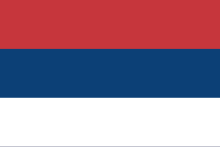Serbs in Slovenia (Serbian: Срби у Словенији, Srbi u Sloveniji, Slovene: Srbi v Sloveniji) are, mostly, first or second generation immigrants from other republics of former Yugoslavia. In the 2002 census, 38,964 people of Slovenia declared Serb ethnicity, corresponding to 2% of the total population, making them the largest ethnic minority in the country.
 Flag of the Serbian minority in Slovenia | |
| Total population | |
|---|---|
| 38,964 (2002) [1] | |
| Regions with significant populations | |
| Ljubljana, Maribor, Kranj, Jesenice, Koper | |
| Languages | |
| Slovenian and Serbian | |
| Religion | |
| Serbian Orthodox Church | |
| Related ethnic groups | |
| South Slavs |
History
editThe vast majority of the Serbs in Slovenia are first or second generation settlers from other republics of former Yugoslavia, mostly from Bosnia and Herzegovina and Serbia, but also from Croatia and Montenegro. After World War II, many Serbs employed in the Yugoslav People's Army were stationed in the Socialist Republic of Slovenia with their families. In the period of 1971-1981, many ethnic Serbs migrated from Bosnia and Herzegovina to pursue better careers and economic opportunities in Slovenia. Before 1991, many Serbs in Slovenia registered as Yugoslavs, and many still prefer referring to their mother language as Serbo-Croatian, rather than Serbian.
There also exists an indigenous community of Serbs in White Carniola from the 16th century (see Serbs of White Carniola).
In 2013, the combined community association of Serbs in Slovenia requested that Serbs be given the status of a national minority.[2]
Demographics
editMost of Serbs in Slovenia are concentrated in larger urban areas, especially in Ljubljana and Jesenice.
The table shows the year, number and percentage of Serbs in Slovenia after World War II, according to the official censuses:
| Year (census data) |
Number of ethnic Serbs | Percent of national population |
|---|---|---|
| 1948 | 7,048 | |
| 1953 | 11,225 | 0.8% |
| 1961 | 13,609 | 0.9% |
| 1971 | 20,521 | 1.2% |
| 1981 | 42,182 | 2.3% |
| 1991 | 47,097 | 2.5% |
| 2002 | 38,964 | 2.0% |
It also has to be noted that in the last census in 2002, more than 10% of the Slovenian population decided not to answer the question regarding their ethnic affiliation. All these elements make the estimate of the overall number of Serbs in Slovenia difficult.
Culture
editYugo-nostalgia is strong among the older generation.[3] The urban former Yugoslav immigrant community in Slovenia had developed a "Balkan culture" in the 1990s.[3]
The Leskovac-styled grilled meat, including ćevapčići, have nowadays become part of the daily diet in Slovenia.[4]
Language
editMost Serbs in Slovenia use Slovene as their language of communication, since only 4,300 people in Slovenia declared that they use only the Serbian language at home, while about 15,000 declared they use both languages at home. However more than 31,000 people declared their mother tongue as Serbian (and another 36,000 as Serbo-Croatian).
A mixed Slovenian–Serbian slang, srboslovenščina, became an "unofficial" language in football and construction, among other traditional domains of post-war immigrants from former Yugoslavia.[5]
Religion
editSerbs in Slovenia are predominantly Eastern Orthodox by faith, adhering to the Serbian Orthodox Church.
Notable people
edit- Ilija Arnautović, architect
- Katarina Branković, Countess of Celje
- Jovan Hadži, zoologist
- Spomenka Hribar, sociologist, politician and public intellectual (Serbian father)
- Zoran Janković, manager and politician, mayor of Ljubljana, Serbian-born, Serbian father
- Dušan Jovanović, theatre director
- Irena Kazazić, painter and writer
- Petar Matić, businessman
- Robert Pešut, a.k.a. "Magnifico", musician and actor (Serbian father)
- Radko Polič, actor
- Božidar Rašica, architect, scenographer and painter
- Simona Škrabec, Slovenian-Catalan author and translator (Serbian father)
- Sportspeople
- Milenko Ačimovič, football player, Serbian parents
- Siniša Anđelković, football player, Serbian parents
- Dragan Gajić, handball player
- Mladen Dabanovič, football player, Serbian parent
- Luka Dončić, basketball player, father of Serbian origin
- Saša Dončić, basketball coach and former player
- Jan Oblak, football player (Serbian mother)
- Sara Isakovič, swimmer (Serbian father)
- Goran Janus, ski jumper and ski jumping coach
- Darko Karapetrovič, football player
- Marko Milič, basketball player, Serbian father
- Rasho Nesterovič, basketball player
- Aleksej Nikolić, basketball player
- Mitja Nikolić, basketball player
- Milivoje Novakovič, football player
- Teja Oblak, basketball player (Serbian mother)
- Damir Pekič, football player
- Danilo Popivoda, football player
- Miroslav Radulovič, football player
- Aleksandar Rodić, football player, Serbian parents
- Marija Šestak, athlete
- Dalibor Stevanovič, football player
- Petar Stojanović, football player
- Slaviša Stojanovič, former football player and manager, Serbian-born
- Dejan Vinčić, volleyball player
- Sasha Vujačić, basketball player, Serbian father
- Marko Vukićević, alpine skier
- Zlatko Zahović, former football player (Bosnian descent)
- Bojan Jokić
See also
editReferences
edit- ^ "Slovenian census". 2011.
- ^ "Slovenija: Srbi traže status nacionalne manjine". Retrieved April 2, 2021.
- ^ a b Resic & Törnquist-Plewa 2016, p. 198.
- ^ Dragana Radojičić. "SERBIAN DISHES ON THE SLOVENIAN TABLE". Traditiones. 39 (1).
[Abstract] The research included immigration trends from Serbia to Slovenia from 1918 to the present, and how these are reflected in the acceptance of food-related products and dishes that originated in Serbia and have become part of Slovenians' everyday diet.
- ^ Resic & Törnquist-Plewa 2016, p. 199.
Sources
edit- Vojislav Stanovčić (2005). Položaj i identitet srpske manjine u jugoistočnoj i centralnoj Evropi: zbornik radova sa naučnog skupa održanog 26-29. novembra 2003. godine. Srpska Akad. Nauka i Umetnosti. ISBN 9788670253889.
- Prelić, Mladena (2009). "The Serbs in Slovenia: A new minority". Glasnik Etnografskog instituta SANU. 57 (2): 53–68. doi:10.2298/GEI0902053P. hdl:21.15107/rcub_dais_8771.
- Resic, Sanimir; Törnquist-Plewa, Barbara (2016). The Balkans in Focus: Cultural Boundaries in Europe. Nordic Academic Press. ISBN 978-91-87121-71-5.